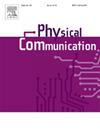On the optimal duplexing strategy for wireless-powered communication networks
IF 2.2
4区 计算机科学
Q3 ENGINEERING, ELECTRICAL & ELECTRONIC
引用次数: 0
Abstract
Due to its simplicity and lack of channel state information (CSI) feedback requirements, time division duplexing (TDD) has been the preferred duplexing method in wireless-powered communication networks (WPCNs), while the advantages of frequency-division duplexing (FDD) has remained largely unexplored. Yet, the decision between TDD and FDD goes beyond CSI considerations, as it depends on various system parameters and operational trade-offs not previously considered. In FDD, the transmitter remains active throughout the entire frame duration, enabling more effective utilization of the maximum instantaneous transmit power of the hybrid access point (HAP). In contrast, TDD exploits the full bandwidth (BW), thereby making better use of the feasible maximum power spectral density (PSD). Finally, while the constraint of maximum time-averaged transmit power in FDD closely resembles the effect of the maximum instantaneous transmit power constraint, they have different effects on the operation of the TDD-WPCN.
To analyze these effects, we thoroughly investigate both TDD-WPCN and FDD-WPCN and characterize their respective operating regions. Our extensive theoretical and simulation results reveal that selecting between the two schemes involves a complex, multidimensional trade-off, warranting careful consideration in system design. We demonstrate that, under certain assumptions, the throughput of an FDD-WPCN can be substantially greater than that of the same WPCN operating in TDD mode. Furthermore we prove that, under certain conditions, a single-node FDD-WPCN can achieve a two-fold increase in throughput compared to a single-node TDD-WPCN.
无线通信网络的最优双工策略研究
由于其简单且缺乏信道状态信息(CSI)反馈要求,时分双工(TDD)一直是无线供电通信网络(wpcn)中首选的双工方法,而频分双工(FDD)的优势在很大程度上尚未得到探索。然而,TDD和FDD之间的决定超出了CSI的考虑范围,因为它依赖于各种系统参数和以前没有考虑过的操作权衡。在FDD中,发射机在整个帧持续时间内保持活动,从而更有效地利用混合接入点(HAP)的最大瞬时发射功率。相比之下,TDD利用全带宽(BW),从而更好地利用可行的最大功率谱密度(PSD)。最后,虽然FDD中的最大时均发射功率约束与最大瞬时发射功率约束的影响非常相似,但它们对TDD-WPCN的运行效果有不同的影响。为了分析这些影响,我们深入研究了TDD-WPCN和FDD-WPCN,并对它们各自的工作区域进行了表征。我们广泛的理论和仿真结果表明,在两种方案之间进行选择涉及复杂的,多维的权衡,需要在系统设计中仔细考虑。我们证明,在某些假设下,FDD-WPCN的吞吐量可以大大大于在TDD模式下工作的相同WPCN的吞吐量。此外,我们证明,在一定条件下,单节点FDD-WPCN可以实现比单节点TDD-WPCN增加两倍的吞吐量。
本文章由计算机程序翻译,如有差异,请以英文原文为准。
求助全文
约1分钟内获得全文
求助全文
来源期刊

Physical Communication
ENGINEERING, ELECTRICAL & ELECTRONICTELECO-TELECOMMUNICATIONS
CiteScore
5.00
自引率
9.10%
发文量
212
审稿时长
55 days
期刊介绍:
PHYCOM: Physical Communication is an international and archival journal providing complete coverage of all topics of interest to those involved in all aspects of physical layer communications. Theoretical research contributions presenting new techniques, concepts or analyses, applied contributions reporting on experiences and experiments, and tutorials are published.
Topics of interest include but are not limited to:
Physical layer issues of Wireless Local Area Networks, WiMAX, Wireless Mesh Networks, Sensor and Ad Hoc Networks, PCS Systems; Radio access protocols and algorithms for the physical layer; Spread Spectrum Communications; Channel Modeling; Detection and Estimation; Modulation and Coding; Multiplexing and Carrier Techniques; Broadband Wireless Communications; Wireless Personal Communications; Multi-user Detection; Signal Separation and Interference rejection: Multimedia Communications over Wireless; DSP Applications to Wireless Systems; Experimental and Prototype Results; Multiple Access Techniques; Space-time Processing; Synchronization Techniques; Error Control Techniques; Cryptography; Software Radios; Tracking; Resource Allocation and Inference Management; Multi-rate and Multi-carrier Communications; Cross layer Design and Optimization; Propagation and Channel Characterization; OFDM Systems; MIMO Systems; Ultra-Wideband Communications; Cognitive Radio System Architectures; Platforms and Hardware Implementations for the Support of Cognitive, Radio Systems; Cognitive Radio Resource Management and Dynamic Spectrum Sharing.
 求助内容:
求助内容: 应助结果提醒方式:
应助结果提醒方式:


